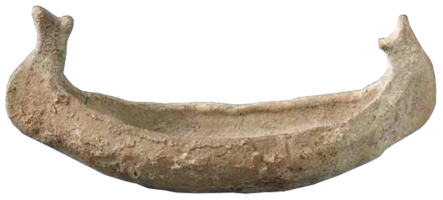Crescentic hull with high vertical posts ending in slightly concave, undecorated extremities. The stem is vertical, with a concave S-shaped external edge, its extremity flaring out. The stern curves inwards. There are no interior fittings.
ship model
C101
Cypro-Archaic
Kition, Ayios Georgios, Tomb 53
L: 13.3 cm; H (stem): 4.9 cm; H(stern): 5.3 cm; H (hull): 3.3 cm; W: 5.4 cm; Th: 0.6 cm
Terracotta ship model, very pale brown slip (10 YR 8/3). Complete, mended from two fragments.
Larnaca District Museum, CS.2539/55
Dolan 2023: 359-360, no. 19; Hadjisavvas 2012: 177, 180, fig. 103. no. 55; Karageorghis 1993: 76, no. GK(ii)7, Pl. XXXII
The Phoenician period necropolis occupied elevated terrain to the north and west of the city, on the only eminences of an otherwise flat marshy land. The tombs in the area had tombstones which were bulldozed from a construction project. Located to the northwest of Larnaca in the central sector of the cemetery, Tomb 53 (CS 2539) was found partially looted in a very disturbed state, as evidenced by a robber’s hole in the northeast side of the chamber. The tomb consists of a trapezoidal chamber (2.8 x 2.6 m) covered by a barrel shaped vault beginning from floor level, with a maximum height of 1.7 m. The chamber was joined to the dromos by an elevated 0.6 m long passage, with the entrance blocked by a gypsum slab. The bones were found in a very poor state of preservation, with evidence of at least five internments: one adult with its skull facing north in the west side of the chamber, while the remaining burials were found in the east, south and central parts of the chamber in a disturbed state. The few identifiable finds were dated to the Cypro-Arhcaic II period. In addition to pottery (bowls, jugs, juglets, amphoriskos), finds include the terracotta boat model, four lamps, a complete amphora of the ‘Canaanite’ type of Plain White V Phoenician ware and more sherds from another, two faience amulets, bronze jewellery (six bracelets, earrings, rings, pendants, a rod, and more bronze fragments), silver jewellery (earring, pendant with shells), an iron earring, a gold necklace pieces, and numerous beads (Hadjisavvas 2012: 174-181). Considering that the tomb was looted, the surviving fragments of gold, silver, and bronze jewellery suggest a fairly rich funerary assemblage.
The closest parallel for the stem's morphology is another Cypriote model of uncertain provenance (C16). The object mistakenly appears twice under two different entries in Dolan's thesis (nos. 14 and 19).
Dolan, M. 2023. Ceci n'est pas un bateau: Reassessing terracotta boat models in Late Bronze and Iron Age Cyprus. University of Southhampton. Unpublished DPhil Thesis.
Hadjisavvas, S. 2012. The Phoenician Period Necropolis of Kition I. Nicosia:
Department of Antiquities, Cyprus.
Karageorghis, V. 1993.The Coroplastic Art of Ancient Cyprus II, Late Cypriote II-Cypro-Geometric III. Nicosia: A.G. Leventis Foundation.










